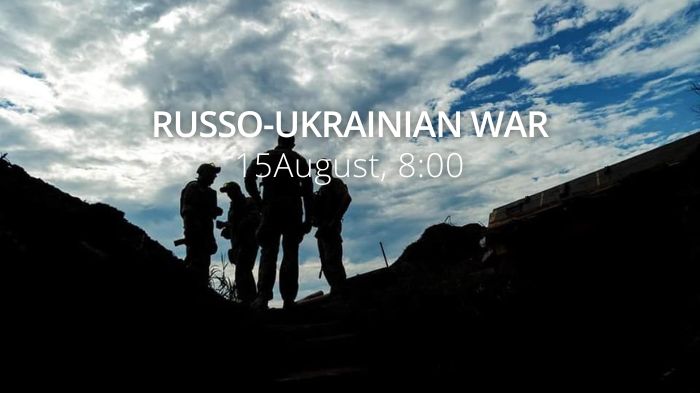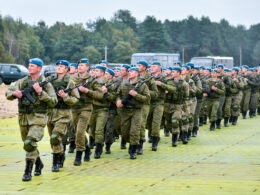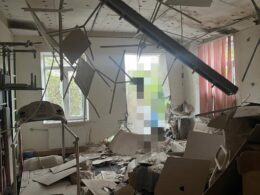Guerillas damaged a bridge near Melitopol. Trains stop moving from Crimea. Ukrainian army hits Wagner HQ in Popasna; smash two Russian ammo depots near Kherson. Ukrainian army targets the Antonivka bridge again, forcing the Russian command to flee. Ukrainian air force units destroy about 15 Russian armored vehicles. Six more ships receive permission to export Ukrainian grain. The EU, 42 countries call on Russia to withdraw its forces from Zaporizhzhia nuclear power plan. New Zealand defense forces to deploy to the UK in further support for Ukraine.
Daily overview — Summary report, August 15
According to military expert Stanislav Haider, as of August 15,
The authorities of Kazakhstan donated ambulances and 20 tons of medical equipment and medicines to the Armed Forces of Ukraine. The Embassy of Israel handed over 100,000 food kits to Ukraine over a week.
Currently, the situation in Donetsk oblast remains difficult. The direction of Bakhmut saw the Russians achieve minimal success as they continued their assaults on the city from three sides. The Ukrainian Armed Forces stopped the occupiers in the areas of Soledar, Vershyna, and Zaitseve. The situation was hard in the area of Kodema. The area of Avdiivka and Mariinka saw failed Russian assaults from the directions of Krasnohorivka and Piski. Ukraine controls Pisky, although there's heavy fighting going on for almost a week. The situation is the same in Mariinka where the Ukrainian forces also repulsed all Russian assaults. The Siversk direction has been active for several days. Fighting continues in the areas of Ivano-Dariivka, Verkhnokamianskyi, Hryhorivka, and Vyimka. The Ukrainian Armed Forces are holding defense.
Kharkiv Oblast saw no significant changes, but, unfortunately, Russia continued its cross-border missile attacks on Kharkiv from Belgorod Oblast continues, although yesterday one of the Russian missiles failed to reach the state border and hit their own settlements. Reportedly yesterday, a tower was blown up in the village of Kozinka (Belgorod Oblast, Russia), from which a stretch of the Ukrainian border could be observed. The direction of Izium saw the Russians deploying reserves to recapture their lost positions in the areas of Brazhkivka and Pasyka.
In Kherson Oblast, the Ukrainian bridgehead at the Inhulets has been stable, some good news comes from the west of Kherson, but there's no official confirmation yet. Thanks to the actions of the Ukrainian military, there already are Russian battalion-tactical groups withdrawn from the right bank of the Dnipro river into Russia's deep rear. As for the damaged bridges, they are still partially passable, which still allows the Russians to transfer the equipment, albeit much slower.
Zaporizhzhia Oblast. Battles continue south of Donetsk's Vuhledar, where the Russian forces want to regain the lost areas. Ukrainian troops continue their successful actions in the areas of Nesterianka and Shcherbaky. A Russian reconnaissance group near Vremivka was neutralized. Ukrainian partisans blew up a railway bridge near Melitopol a couple of days ago. Also, the Russians continue to regroup and concentrate their troops in the Tokmak-Melitopol areas, as well as on the border with Kherson Oblast.
The Ukrainian artillery units destroyed:
- Russian military bases in Tokmak district (Zaporizhzhia Oblast), Popasna (Luhansk Oblast),
- A Russian ammunition warehouse in Beryslav district (Kherson Oblast).
In total, the past week saw the elimination of 22 Russian ammunition depots, 10 bases, 3 command points, and 1 barracks building.
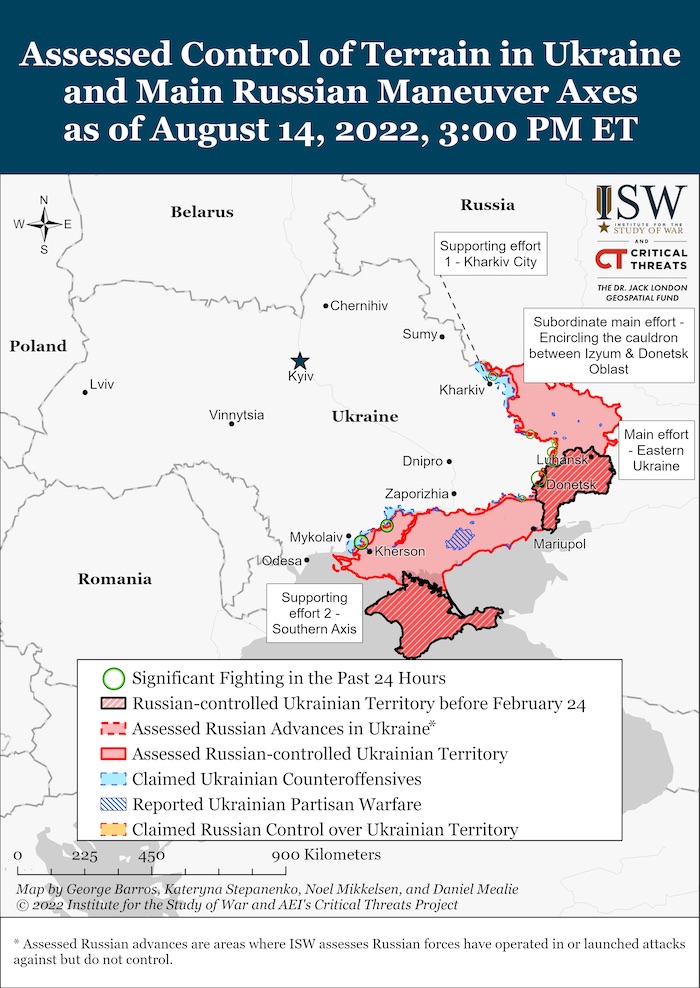
The General Staff’s operational update regarding the Russian invasion as of 06.00 am, August 15, 2022 is in the dropdown menu below.
“[The situation has not undergone significant changes in the Volyn and Polissky directions.]
[There are up to four battalion tactical groups of Russian forces in the Siversky direction. The rotation of the specified units is ongoing. Russian forces yesterday shelled the areas of Senkivka in the Chernihiv region and Starykovo, Atynskyi and Zhuravka in the Sumy region with barrel artillery.] Russian forces fired artillery on the areas of Lyute, Iskryskivshchyna and Bilovody settlements of the Sumy oblast.
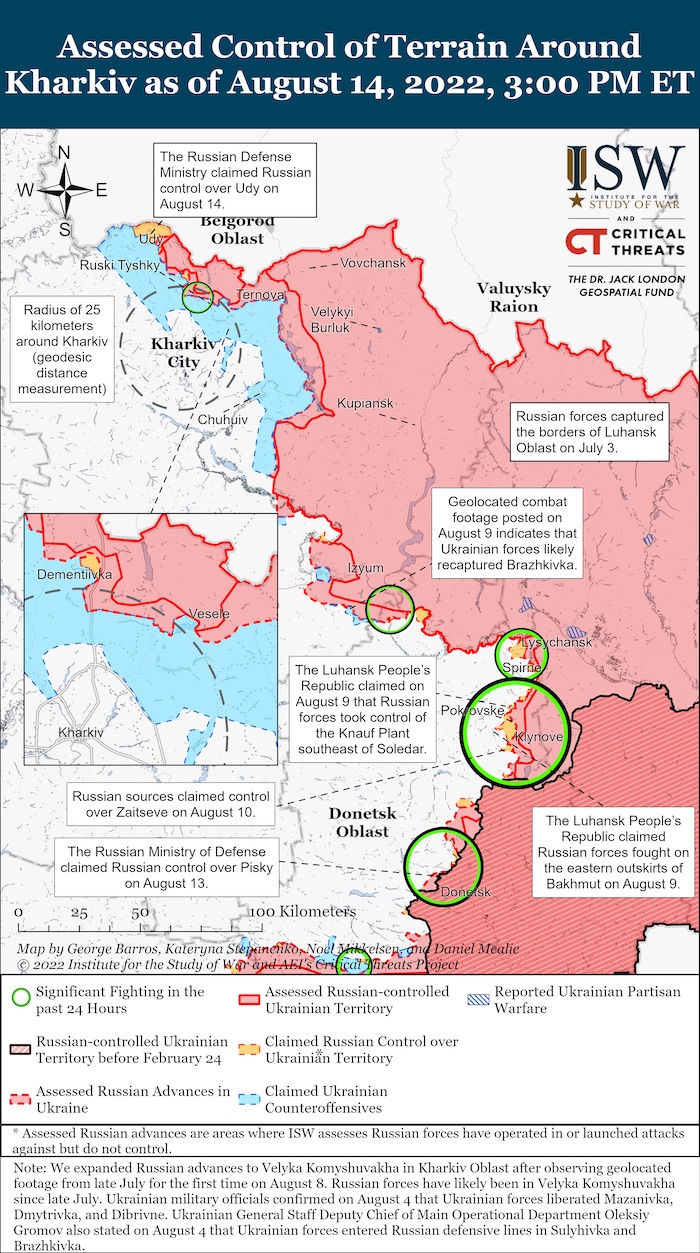
[In the Slobozhansky direction:]
- In the Kharkiv direction, Russian forces shelled the areas of Svitlychne, Shapovalivka, Prudyanka, Dementiivka, Pytomnyk, Velyki Prohody, Ruski Tyshki, Peremoha, Verkhniy Saltiv, Husarivka, Bazaliivka, Stara Hnylytsia and Protopopivka settlements from tanks and rocket artillery. Carried out airstrikes near Rtyshchivka and Verkhnyi Saltiv. [Yesterday, Russian forces used tanks and artillery of various types to shell the areas of the settlements of Uda, Borshchev, Zolochiv, Bezruky, Novye, Rtyshchivka, Ruska Lozova, Cherkassky Tyshki, Petrivka, Stary Saltiv, Mospanove, Korobochkine, Pryshyb, Bayrak and Chepil.]
- [Carried out airstrikes near Peremogy, Pitomnyk and Verkhniy Saltov.]
- In the Sloviansk direction, Russian forces carried out fire damage from artillery of various types near Velyka Komyshuvakha, Brazhivka, Zalyman, Virnopilla, Mazanivka, and Bohorodychne. It conducted an assault in the direction of Tychotske - Dolyna, was unsuccessful, suffered losses, and withdrew. [Yesterday, he carried out fire damage from artillery and MLRS near Hrushuvaha, Dolyna, Krasnopill, Dibrivny, Kurulka, Protopopivka, and Nortsivka.]
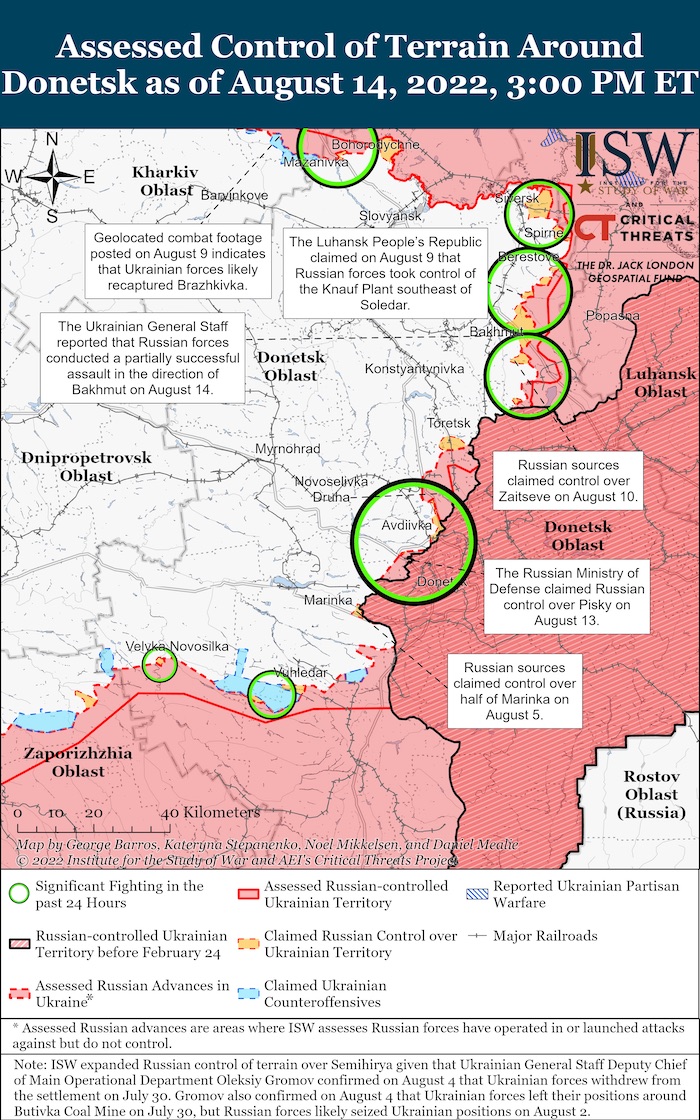
In the Donetsk direction:]
- In the Kramatorsk direction, Russian forces are trying to conduct offensive actions. Actively uses assault and army aviation. Shelling was recorded near Bilohorivka, Hryhorivka, Starodubivka, Vesele, Fedorivka, and Siversk. [Yesterday, Russian forces used tanks and MLRS to shell the Verkhnokamyansky, Serebryanka, Spirny, Ivano-Daryivka, Rozdolivka, and Pereizny districts.]
- [Attempted to conduct reconnaissance of the positions of our troops in the Serebryanka area, was hit by fire and retreated. An attempt to reconnoitre by fighting in the direction of Vesely ended with retreat.]
- [Russian forces risked an assault near Spirny and Ivano-Daryivka. Everything ended for the occupiers with losses and retreat.]
- In the Bakhmut direction, Russian forces intensified reconnaissance of the front edge of our defence and carried out shelling from artillery and tanks near Toretsk, Bakhmutske, Bilohorivka, Kurdyumivka, Vasylivka, Zaytseve, and Zalizne. It carried out airstrikes in the area of the settlement of Soledar. [Yesterday, shelling was recorded near Kostiantynivka, Bakhmut, Soledar, Shumy, Yakovlivka, Kodema and Vershina. Russian forces also carried out airstrikes near Soledar, Yakovlivka and Kodem.]
- [Ukrainian soldiers inflicted fire damage and neutralized a Russian reconnaissance group in the direction of Soledar.]
- It led offensive battles in the direction of Soledar and Kodema, had no success, and withdrew. [Yesterday, they waged offensive battles in the directions of Yakovlivka, Soledar, Vershina, Kodem and Zaitsevo, suffered losses and retreated. Enemy units had partial success in the direction of Bakhmut.]
- In the Avdiivka direction, shelling was recorded near Sribne, Krasnohorivka, Opytne, Pervomaiske, Novobakhmutivka, and Mariinka, as well as an airstrike near Krasnohorivka. [Yesterday, Russian forces shelled the districts of Avdiivka, Nevelskyi, Piskivy, Vodyanyi, Karlivka, and New York with artillery of various calibres. In addition, he carried out an air strike near Krasnohorivka.]
- In order to improve the tactical position, the occupiers conducted offensive battles in the direction of Pisky and Pervomaiske, they did not succeed, they retreated.[Yesterday, Russian forces carried out assaults in the direction of Krasnohorivka and Piskiy, were unsuccessful and retreated.]
- In the Novopavlivske and Zaporizhzhia directions, Russian forces fired tanks, artillery and MLRS in the areas of the settlements of Vuhledar, Velyka Novosilka, Novomykhailivka, Novodanylivka, Ternuvate, Burlatske, Charivne, Zelene Pole, Mala Tokmachka, Poltavka, Novoandriivka and Privilne. [Yesterday, the occupiers fired tanks and artillery near Orikhov, Kostiantynivka, Pavlivka, and ten other settlements. Airstrikes were carried out near Novosilka, Novoandriivka and Shcherbaki. Russian forces continue conducting aerial reconnaissance by UAVs of the operational-tactical level.]
- Conducted aerial reconnaissance of the UAVs near Stepnohirsk, Shcherbaky, Stepove and Hulyaipole. In the direction of the settlement of Vremivka, our soldiers neutralized a reconnaissance group of the occupiers. Russian forces waged offensive battles in the direction of Pavlivka, had no success, and retreated. [Yesterday, they waged unsuccessful offensive battles in the direction of Pavlivka and Vremivka.]
In the Pivdenny Buh direction, Russian forces are concentrating their main efforts on holding the occupied areas. It carried out shelling from tanks, artillery and MLRS in the areas of the settlements of Stepova Dolyna, Lymany, Prybuzke, Novomykolaivka, Kotlyareve, Partyzanske, Pervomaiske, Blahodatne, Kobzartsi, Vesely Kut, Ternivka, Andriivka, Lozove, Tokareve, Zarichne, and Olhyne. Airstrikes near Bilohirka and Andriyivka. [Yesterday, Russian forces shelled the areas of the settlements of Posad-Pokrovske, Oleksandrivka, Olenivka, Myrne, Shiroke, Polyana, Pavlo-Maryanivka, Chervona Dolyna, Kiselyvka, Ternivka, Velike Artakove, Bila Krynytsia, Potemkine and Trudolyubivka, Ivanivka from tanks, barrel artillery, and multiple rocket systems. Used aviation for strikes near Biloghirka and Veliky Artakovo. Conducted aerial reconnaissance with UAV.]
- Conducted aerial reconnaissance of the UAVs near Snihurivka, Chervony Yar and Bila Krynytsia.
Two warships with Kalibr cruise missile carriers are ready to use high-precision weapons.”
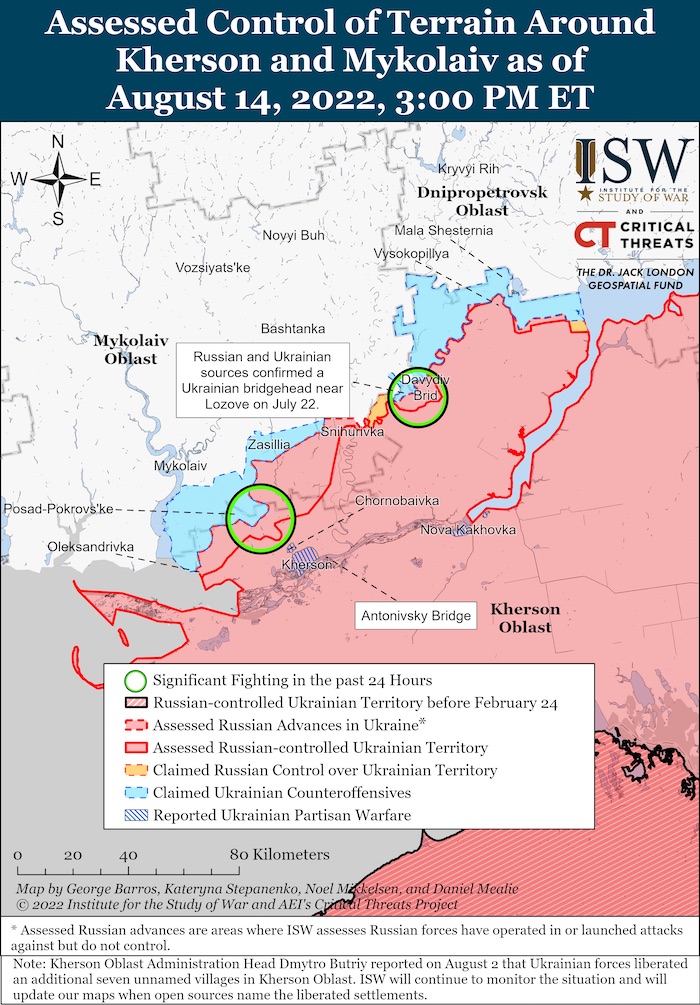
Military Updates
Guerillas damaged bridge near Melitopol, trains stop moving from Crimea, Ukrinform reports. “For the second day, Russian invaders have been unable to restore a damaged railway bridge over which military trains were coming from Crimea.”
Update: Nataliia Humeniuk, press secretary of the Operational Command South, has confirmed last night's Ukrainian strike on the Antonivskyi bridge. She announced this on the air of the national telethon.https://t.co/9sqBCcJP3m https://t.co/Vtd4Jra3fo
— Euromaidan Press (@EuromaidanPress) August 14, 2022
Armed Forces of Ukraine hit Wagner HQ in Popasna, the photo of which was exposed by Russian war reporter, Ukrainska Pravda reports, citing the Russian department of Radio Liberty. “Reports of the Armed Forces of Ukraine attack on the Wagner PMC headquarters in Popasna appeared on Sunday in Russian telegram channels. A photo of the destruction was also published. According to Radio Liberty, the telegram channels of Wagner PMC confirm the strike.
https://twitter.com/EuromaidanPress/status/1558898753729339392
On 8 August, Russian military correspondent Sergey Sereda wrote about his visit to the "headquarters". He published a post on Telegram. According to Radio Liberty, one of the photos that he posted shows Yevgeny Prigozhin [a Russian oligarch who controls a network of companies], who is believed to be the owner of Wagner PMC, although he himself denies it. These photos pissed off many pro-Russian commentators, as one of them shows a sign with the address of the nearest bomb shelter - Myronivska Street, 12.”
Ukraine’s Armed Forces destroy two Russian Ka-52 helicopters this weekend, Ukrinform reports, citing the Joint Forces Task Force. "The units of the anti-aircraft missile forces of the Khortytsia operational-strategic group perform their duties diligently even on weekends. As a result, two Ka-52 fire support helicopters were destroyed on Saturday and Sunday."
Two enemy ammo depots in the Kherson region were smashed, Ukrinform reports. "It has been officially confirmed that the explosions heard in Muzykivka and Nova Kakhovka during the day signified the destruction of two enemy ammunition depots, Serhii Khlan, a member of the Kherson Regional Council, posted on Facebook.”
Air Force units destroy about 15 Russian armored vehicles, Ukrinform reports, citing the press service of the Air Force
of the Armed Forces of Ukraine. "On August 13, in several operational directions, the strike aircraft of the Air Force of the Armed Forces of Ukraine launched up to ten group airstrikes on the positions of the occupying forces. Under the cover of fighter aircraft, Su-25 attack aircraft and Su-24m bombers struck platoon and company strongholds, tank columns on the march, positions of rocket launcher systems, and crossings.
Attacks were also launched on concentrations of enemy manpower and equipment. "The Air Force destroyed about fifteen enemy armoured personnel vehicles and dozens of ruscists," the press service added.”
Russian commanders in southern Ukraine move their posts to Dnipro’s left bank, Ukrainska Pravda reported on Saturday, citing Vitalii Kim, Head of the Mykolaiv Oblast Military Administration. “Military leadership of the Russian occupying forces in southern Ukraine have moved their posts to the left [eastern] bank of the Dnipro river.”
Ukrainian Armed Forces target Antonivka bridge once again, forcing Russian command to flee, Ukrainska Pravda reported Sunday. The Armed Forces of Ukraine landed another strike on the Antonivka road bridge in Kherson Oblast on the night of 13 August. Nataliia Humeniuk, head of the Joint Coordination Press Centre of the Defence Forces of the south of Ukraine confirmed that the Ukrainian Armed Forces had already carried out strikes on the Antonivka road and railway bridges in Kherson, as well as the Kakhovka Bridge.
This means that the transfer of heavy military vehicles and equipment, as well as ammunition supplies, has been significantly complicated, if not made impossible. We are continuing to establish the exact outcomes [of our actions]. When we have a comprehensive understanding of whether these supply routes can be used, including a confirmation from experts, then we will be able to announce this properly, Humeniuk said.
She added that the military command of the Russian Armed Forces [in Kherson Oblast] are using the remnants of these transport routes to evacuate to the left bank of Dnipro in order to ensure their own safety."
Following Ukrainian strikes hitting Kherson bridges, invaders are fleeing to Melitopol, Ukrinform reports, citing Melitopol Mayor Ivan Fedorov. “The "leadership" of the occupation forces began to flee toward the temporarily occupied Melitopol of the Zaporizhzhia region after the bridges were damaged in the Kherson region. They are redeploying to Melitopol, because it is the closest point to occupied Crimea, so they seek to command forces from there, the official said.”
According to British Defence Intelligence, (last 48 hours):
According to British Defence Intelligence, (last 48 hours):
- On 11 August 2022, Russian media reported that Denis Pushilin, head of the so-called Donetsk People’s Republic (DNR), had said that the date of a referendum on the DNR joining Russia will be announced after the DNR’s ‘complete liberation.
- Previously, in June 2022, investigative journalists published evidence of a DNR planning strategy for running such a referendum and for ensuring that at least 70 per cent of votes were in favour of joining Russia. It is likely that Russia is in the advanced planning stages to hold a referendum, though it is unclear if the final decision to go ahead with a vote has yet been taken.
- The Kremlin will likely see the military's failure to occupy the entirety of Donetsk Oblast thus far as a setback for its maximalist objectives in Ukraine.
- Over the past week, Russia’s priority has likely been to re-orientate units to reinforce southern Ukraine. However, in the Donbas, Russian-backed forces – largely militia of the self-proclaimed Donetsk People’s Republic – have continued to attempt assaults to the north of Donetsk city.
- Particularly heavy fighting has focused on the village of Pisky, near the site of Donetsk Airport. The settlement probably remains contested. The area has been on the front line of the Donbas Line of Control since 2014. The Russian assault likely aims to secure the M04 highway, the main approach to Donetsk from the west..
Losses of the Russian army
As of Monday 15 August, the approximate losses of weapons and military equipment of the Russian Armed Forces from the beginning of the war to the present day:
- Personnel – more than 43750 (+200),
- Tanks – 1876 (+12),
- Armoured combat vehicles – 4141 (+15),
- Artillery systems – 985 (+5),
- Multiple rocket launchers –MLRS - 261 (+0),
- Air defence means – 136 (+0),
- Aircraft - 233 (+0),
- Helicopters - 195 (+1),
- Automotive technology and fuel tanks – 3044 (+5),
- Vessels/boats - 15 (+0),
- UAV operational and tactical level – 787 (+3),
- Special equipment – 92 (+1),
- Mobile SRBM system – 4 (+0),
- Cruise missiles – 187 (+0)
Russian enemy suffered the greatest losses (of the last day) in the Donetsk direction.
⚰️russia's combat losses in Ukraine as of August 15
▪ 43750 killed soldiers (+200)
▪ 4141 APV (+15)
▪ 1876 tanks (+12)
▪ 985 artillery systems (+5)
▪ 233 aircraft and 195 helicopters (+1)
▪ 15 boats and cutters#StopRussia #StandWithUkraine pic.twitter.com/4b2uVIACuv— VoxUkraine (@voxukraine) August 15, 2022
Humanitarian
Heartwarming stories, #war style. A #Ukrainian fixer accompanying journalists to the front line rescues two dogs and helps family reunite.
Read more: https://t.co/sTWDtUVLbm#Odesa #Ukraine #UkraineRussianWar #RussiaIsATerroristState pic.twitter.com/zZdt9Dv0Zb
— FixersUA (@FixersUa) August 13, 2022
Six more ships receive permission to export Ukrainian grain, Ukrinform reports, citing Voice of America. “The Joint Coordination Center within the framework of the UN Black Sea Grain Initiative allowed six ships to pass through the maritime humanitarian corridor in the Black Sea.
As noted, two of these vessels – MV Kafkam Etler and MV Zelek Star – have already been inspected in the Sea of Marmara and can head towards Chornomorsk, Odesa region, to get loaded. Ships MV Great Arsenal, MV Zumrut Ana, MV Ocean S, and MV Kubrosliy will leave for Chornomorsk port after inspection. In addition, on Sunday, MV Star Laura was inspected and cleared for departure. On Saturday, MV Rahmi Yagci passed inspection.
According to the procedures agreed on by the JCC, all inspection participants coordinate work with their military and other relevant bodies. This is necessary "to enable the safe passage of commercial vessels within the framework of the Black Sea Grain Initiative."
https://twitter.com/EuromaidanPress/status/1558808751905415169
️️Environmental
42 countries called on Russia to withdraw its troops from Zaporizhzhia Nuclear Power Plant
"Deployment of Russian troops and weaponry at the nuclear facility disregards the safety, security, and safeguards principles," the statement says.https://t.co/uTMmzSXVGT
— Euromaidan Press (@EuromaidanPress) August 14, 2022
The EU, 42 countries call on Russia to withdraw its forces from Zaporizhzhia NPP, Ukrinform reports. “A joint statement dated August 12 on the situation at the Zaporizhzhia Nuclear Power Plant was published on Sunday on the website of the EU Delegation to the International Organizations in Vienna.
We urge the Russian Federation to immediately withdraw its military forces and all other unauthorized personnel from the Zaporizhzhia Nuclear Power Plant, its immediate surroundings, and all of Ukraine so that the operator and the Ukrainian authorities can resume their sovereign responsibilities within Ukraine’s internationally recognized borders and the legitimate operating staff can conduct their duties without outside interference, threat, or unacceptably harsh working conditions," the statement said.
It added that this would also enable the IAEA to carry out its verification pursuant to Ukraine’s safeguards obligations under safe and secure conditions and in a timely manner. The EU and 42 countries emphasized that the deployment of Russian military personnel and weaponry at the nuclear facility "is unacceptable and disregards the safety, security, and safeguards principles that all members of the IAEA have committed to respect. […]
The statement was issued on behalf of Australia, Austria, Belgium, Bulgaria, Canada, Croatia, Cyprus, Czech Republic, Denmark, Estonia, Finland, France, Georgia, Germany, Greece, Hungary, Iceland, Ireland, Italy, Japan, Latvia, Liechtenstein, Lithuania, Luxembourg, Malta, Montenegro, Netherlands, New Zealand, North Macedonia, Norway, Poland, Portugal, Republic of Korea, Republic of Moldova, Romania, Slovakia, Slovenia, Spain, Sweden, Türkiye, United Kingdom of Great Britain and Northern Ireland, United States of America, as well as the European Union.”
Legal
Chief Intelligence Directorate names details of commanders whose soldiers are firing cruise missiles at Ukrainians
, Ukrainska Pravda reports, citing Defence Intelligence of Ukraine (DIU). DIU “has named the commanders of several of the Russian occupiers’ military units whose servicemen have launched missile strikes from Tu-22M3 and Tu-160 aircraft using X-22, x-555 and X-101 cruise missiles at cities and civilians in Ukraine. It has been reported that Russian personnel from the following units are involved in launching missile strikes from Tu-22M3 and Tu-160 aircraft using X-22, X-555 and X-101 cruise missiles on cities and civilians of Ukraine:
- 22nd Heavy Bomber Aviation Division (military unit 06987, Engels)
- 121 Heavy Bomber Aviation Regiment (military unit 85924, Engels)
- 52 Heavy Bomber Air Regiment (military unit 33310, Shaikovka)”
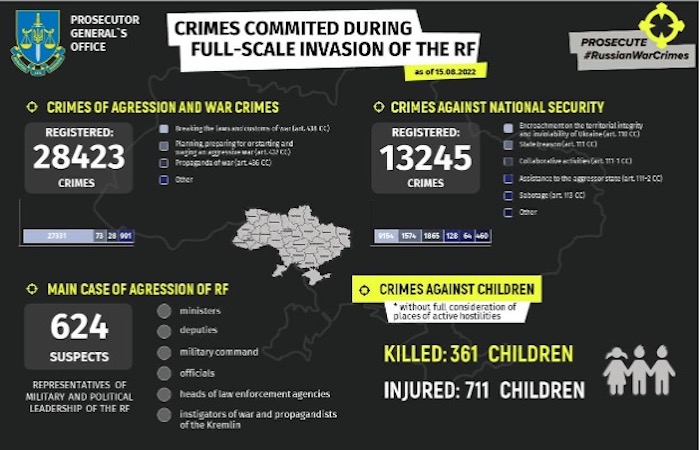
361 children were killed, 711 children injured, 6,482 deported by foe forces, and 227 reported missing - the Office of the Prosecutor General of Ukraine reports as of August 15. 2,328 educational establishments are damaged as a result of shelling and bombings, 289 of them are destroyed fully. 28,423 crimes of aggression and war crimes and 13,245 crimes against national security were registered.
22,000 civilian objects have been hit since the beginning of the war, Ukrinform reports, citing Suspilne. "We see the numbers: more than 22,000 civilian objects and only about 300 military objects hit. We see cruise missiles flying directly over nuclear power facilities, we see enemy missiles hitting critical infrastructure objects, chemical production facilities, First Deputy Minister of Internal Affairs of Ukraine Yevheniy Yenin said.
As noted, the invaders also affect cultural heritage sites, including religious buildings, as well as shopping malls and schools. Yenin emphasized that any object could become a target of missile and bomb strikes launched by Russian troops.”
Support
NZDF to deploy to the UK in further support for Ukraine, NZDF.MIL reports. “The New Zealand Defence Force (NZDF) will over the next three weeks begin to deploy up to 120 personnel to the United Kingdom to train Ukrainian infantry recruits. The deployment, announced by the Government today, extends until 30 November and will see an infantry training contingent, drawn from the New Zealand Army, split into two teams to train approximately 800 Ukrainian Armed Forces personnel.”
72nd Mechanized Brigade gets state-of-the-art reconnaissance drone, Ukrinform reports, citing Ukraine's Deputy Prime Minister and Minister of Digital Transformation Mykhailo Fedorov. "We handed over a state-of-the-art DJI Matrice 300 drone to the legendary 72nd Brigade named after the Black Zaporozhians. […] He said that contracts worth UAH 474 million had been signed as part of the Army of Drones project. Some of the attack drones and reconnaissance UAVs are already on the front lines, and the rest will be handed over to Ukrainian defenders in the near future.
On July 1, the General Staff of the Ukrainian Armed Forces, the Ministry of Digital Transformation and the United24 platform announced the launch of the Army of Drones project. This is a comprehensive program that includes the systematic purchase of drones, their repair and operational replacement, as well as a pilot training course.”
New Developments
Russia buys 1,000 drones from Iran, @ejmalrai reports.
In that case we need air defense systems and attack drones, or a lot more of our Defenders will die.
We need MQ-1 Predator and MQ-9 Reaper drones.#ArmUkraineNow pic.twitter.com/yrDePgCs9F
— Anton Gerashchenko (@Gerashchenko_en) August 14, 2022
- The Verkhovna Rada committee supports the extension of martial law and mobilisation, Ukrainska Pravda “The Verkhovna Rada Committee for National Security and Defence supported the bills on extending martial law and general mobilisation for 90 days, which were previously introduced by President Volodymyr Zelensky.”
- Poland to stop issuing visas to Russian citizens, UAWire “Poland announced it will be stopping issuing visas to Russian citizens. The country's authorities are also working on a procedure that will allow to refuse EU visas to Russians, saidthe Deputy Head of the Polish Foreign Ministry, Piotr Wawrzyk. According to him, the decision will be made in the coming weeks. On August 11, Estonian officials said the Estonian government will not allow Russians with Schengen visas to enter the country. The authorities of Lithuania, Latvia, the Czech Republic and Slovakia also spoke in favour of the ban on issuing visas to citizens of the Russian Federation.”
Ukrainian President declares that Russians who don't express their position against war in Ukraine, support it
"When evil acquires such proportions, people's silence approaches the level of complicity," - Zelenskyi said.https://t.co/rO9DJnkctT
— Euromaidan Press (@EuromaidanPress) August 14, 2022
- Zelenskyy to Russians: If you remain silent, you are complicit in war, Ukrainska Pravda "[W]hen evil takes on such proportions, people’s silence approaches the level of complicity. And refraining from taking up an active stance against evil will only assist it. Therefore, if you have Russian citizenship and you are silent, it means that you are not fighting, and thus that you are supporting evil. And no matter where you are, on the territory of Russia or abroad, you must voice your support for Ukraine, and therefore voice your opposition to this war."
- Moscow warns of the end to Russia-US relations if assets are seized, Reuters “Any possible seizure of Russian assets by the United States will completely destroy Moscow's bilateral relations with Washington, TASS quoted the head of the North American Department at the Russian foreign ministry as saying on Saturday.”
Assessment
- On the war.
The Institute for the Study of War has made the following assessment as of 14 August, 2022:
“Russian and proxy troops in Ukraine are likely operating in roughly six groups of forces oriented on Kharkiv City and northeastern Kharkiv Oblast; along the Izium-Sloviansk line; the Siversk-Lysychansk area; Bakhmut; the Avdiivka-Donetsk City area; and Southern Ukraine. The Kharkiv City and Siversk-Lysychansk groups are likely built around cores drawn from the Western and Central Military Districts respectively. The Izium-Sloviansk axis is increasingly manned by recently formed volunteer battalions that likely have very low combat power. Wagner Group private military company (PMC) soldiers are in the lead around Bakhmut, while forces drawn from the Donetsk People’s Republic (DNR) predominate in the Avdiivka-Donetsk City area. Troops from the Southern Military District (SMD) likely formed the original core of forces in Kherson and Zaporizhzhia Oblasts but have been reinforced with troops of the Eastern Military District, Airborne Forces, and Rosgvardia. None of these groupings is homogeneous—elements of various military districts, proxy forces, volunteer units, and other formations are scattered throughout the theatre.
These dispositions suggest that Moscow is prioritizing the advance around Bakhmut and, possibly, toward Siversk with its Russian forces while seeking to draw on the enthusiasm of DNR forces to seize ground they have failed to take since 2014 on the Avdiivka axis. The high concentration of volunteer battalions around Izium and Sloviansk suggests that that area is not a focus of Russian attention and may be vulnerable to Ukrainian counterattacks. The congeries of forces in and around Kherson Oblast may pose significant challenges to Russian command and control, especially if Ukrainian forces press a counteroffensive there.
Kharkiv City and northeastern Kharkiv Oblast:
Mainly Western Military District units
Russian force composition around Kharkiv City is at least in part composed of Western Military District (WMD) units. The Ukrainian General Staff has identified that Russian forces concentrated WMD units around Kharkiv City and in border areas of Russia’s Kursk and Bryansk Oblasts (northeast of the city). Russian offensive operations on this axis have generally been desultory and suggest a lack of focus, possibly reflected in more limited force deployments.
Izium-Sloviansk line:
Mainly Volunteer Battalions and some Eastern Military District units
Russian forces are likely committing volunteer units and some remaining detachments of the Eastern Military District (EMD) to the Izium-Sloviansk line and are likely deprioritizing the axis in favor of defending positions in southern Ukraine. Ukrainian military officials reported that EMD elements that had previously supported offensive operations towards Sloviansk have been redeploying to the Southern Axis in an effort to defend occupied territories in western Zaporizhzhia and Kherson Oblasts. Russian outlets and Telegram channels have begun identifying and announcing recruitment for volunteer units operating near Izium around reports of Ukrainian counteroffensive preparations. Russian media outlet Readovka reported that the volunteer Cossack detachments “Yermak” and “Kuban” are recruiting reinforcements for offensive operations in Kharkiv Oblast, likely around Izium given that Cossack units have been operating in the area since April. Kremlin-affiliated outlet Kommersant also reported that the “Don” Cossack Detachment that has been fighting around Velyka Komyshyvakha (southwest of Izium) since April is joining volunteer and other Cossack units (including the ”Kuban” detachment). Russian war correspondent Sasha Kots reported that the “Russian Legion” is recruiting personnel to operate on the Kharkiv-Donetsk Oblast border. The “Russian Legion” has reportedly operated southeast of Izium since entering Ukraine on May 12. Reliance on volunteer forces may explain the lack of Russian progress and some successful Ukrainian counterattacks on the Izium-Sloviansk line.
Siversk-Lysychansk:
Central Military District with some DNR and LNR units
Units of the Russian Central Military District (CMD) and some LNR and DNR units are operating on the Siversk-Lysychansk axis and have resumed their offensive operations likely following an operational pause initiated in late July. CMD Commander Colonel General Aleksandr Lapin visited Lysychansk on August 8 and likely ordered CMD troops to resume offensive operations towards Siversk during his visit. The Russian Defense Ministry identified Lapin as responsible for securing Lysychansk on July 3, and he had likely continued to command the troops in the area since then. The grouping has been consistently launching offensive operations in the Siversk area since August 8, whereas they had previously engaged in sporadic limited assaults usually at two-to-three-day intervals. Social media footage published on Twitter on August 5 showed elements of the Russian 55th Motorized Rifle Brigade of the 41st Combined Arms Army of the CMD reportedly operating in the direction of Siversk. ISW has previously reported that Russian forces also moved a CMD battalion tactical group (BTG) to the Sievierodonetsk-Lysychansk area in late June.
Bakhmut:
Wagner Group with LNR and some WMD units
Detachments of the Wagner Group private military company (PMC) have been active in Russian efforts to gain ground around Bakhmut and have likely contributed to recent successes in this area. Various Russian and Ukrainian sources reported that Wagner Group mercenaries were instrumental in the previous captures of Pokrovske (due east of Bakhmut), Klynove (18km southeast of Bakhmut), Novoluhanske (25km southeast of Bakhmut), and the Vuhlehirska Power Plant (about 20km southeast of Bakhmut). Russian Telegram channels lauded the work of the Wagner Group in completing the tactically complicated capture of the Vuhlehirska Power Plant on July 26, showing the approval that the Russian information space has recently awarded the Wagner Group. LNR units, such as the 6th Cossack Regiment, and other WMD detachments are operating in the Bakhmut direction as well.
The Wagner Group also reportedly maintains a headquarters in Popasna, about 40km northeast of Bakhmut. A Russian miblogger posted imagery on Telegram of his reported visit to the Wagner Group headquarters, which he claimed was in Popasna, on August 9. This location likely allows Wagner Group command to coordinate various offensive operations in northeastern Donetsk Oblast from well within Russian-occupied territory in Luhansk Oblast. Various Russian and Ukrainian sources reported that Ukrainian forces targeted and destroyed the headquarters on August 14, possibly based on geolocation of the aforementioned milblogger’s Telegram post. The strike may impact Wagner’s command and control abilities in the Bakhmut area.
Avdiivka-Donetsk City:
DNR units
DNR units, which have been operating in the area since 2014, are operating in the Avdiivka-Donetsk City area after likely having participated in operations to seize Luhansk Oblast. DNR-based milbloggers and war correspondents have been publishing footage of the DNR 1st Slavic Brigade, 5th Brigade, and the 11th Regiment making limited advances north and northwest of Donetsk City. The DNR also began advertising volunteer recruitment for the DNR 100th Guards Separate Motorized Rifle Brigade, and Ukrainian officials reported that Russian occupation authorities have begun to mobilize men from Mariupol to join DNR efforts. Readovka also identified that one unspecified Cossack detachment is operating around Mariinka, northwest of Donetsk City. ISW has previously assessed that DNR-based milbloggers have increased their coverage of small-scale progress on the Avdiivka-Donetsk City axis likely in an effort to boost morale among DNR and Russian fighters. It is likely that such coverage is aimed at recruiting more DNR fighters to support the attempted breakthroughs around Donetsk City.
Southern Ukraine:
Mixed
The Russian force composition along the Southern Axis is relatively more diverse than that of other axes. Russian military leadership has likely rushed a mix of forces to this area to defend it against an expected Ukrainian counteroffensive, which likely explains the wide variety of force groupings in this area. ISW has observed elements of the 35th and 36th Combined Arms Armies (CAA) of the Eastern Military District (EMD), the 22nd Army Corps of the Black Sea Fleet, the 49th CAA of the Southern Military District (SMD), 76th Guards Air Assault Division, and Rosgvardia throughout Southern Ukraine.
Ukraine’s Southern Operational Command noted on August 3 that Russian forces were sending elements of the 35th CAA to northern Kherson Oblast. Various Ukrainian officials reported on August 3 that Ukrainian forces destroyed a command post of the 22nd Army Corps in Chornobaivka, on the outskirts of Kherson City. Ukrainian forces additionally targeted control points of the 76th Air Assault Division in Chornobaivka on August 5. Elements of the 49th CAA reportedly have been active on the western bank of the Dnipro River, particularly in the Snihurivka area of Mykolaiv Oblast. Deputy Chief of Ukraine’s Main Operational Department of the General Staff Oleksiy Gromov stated on August 4 that elements of Rosgvardia (Russia’s internal military force) moved to the eastern bank of Dnipro River, suggesting that Russian forces are prioritizing securing the defense of this bank.
Key Takeaways
- Russian and proxy troops in Ukraine are operating in roughly six force groupings.
- Russian forces conducted ground attacks north of Kharkiv City, northwest of Sloviansk, east of Siversk, and made unspecified gains around Bakhmut.
- Ukrainian forces reportedly struck a Wagner force concentration in Popasna, Luhansk Oblast, inflicting casualties.
- Ukrainian forces struck the Antonivsky road bridge, likely keeping all three road bridges to and on the right bank of the Dnipro inoperable to heavy equipment.
- Russian military recruitment and enlistment centers continue to face challenges in incentivizing Russians to sign military service contracts.
Russian occupation authorities continued rubleization measures and civilian data collection in occupied territories to set conditions for annexation referenda.“
With New Weaponry, Ukraine Is Subtly Shifting Its War Strategy, The New York Times reports. “Striking deep behind enemy lines, the Ukrainians are depleting Russia’s combat potential, slowing its advance in the east and creating new vulnerabilities in the south. From spring into summer, the Ukrainian military was pummeled by Russian artillery in eastern Ukraine, steadily losing ground and as many as 200 soldiers a day in a mismatched, head-to-head contest. But in recent weeks, Ukraine has shifted its strategy with the help of new weaponry and succeeded, at least for now, in slowing Russia’s advances.
Supplied with a growing arsenal of long-range Western weapons and aided by local fighters known as partisans, Ukraine has been able to hit Russian forces deep behind enemy lines, disrupting critical supply lines and, increasingly, striking targets that are key to Moscow’s combat potential. The new weapons have also forced Russia to recalibrate on the battlefield, creating some breathing room for the Ukrainians to make more strategic decisions.
One blow to the Russians this week was a series of explosions at an air base on the occupied Crimean Peninsula that destroyed at least eight warplanes, and that a Ukrainian official said had resulted from a strike carried out by special forces troops aided by local partisan fighters.
The approach has been particularly well suited to the Kherson region in the south, where for weeks Ukrainian officials have been engaged in the opening salvos of a counter-offensive. The city of Kherson in particular, dependent for supplies on just four bridges spanning the Dnipro River, is considered more vulnerable than other occupied cities.
On Saturday, the Ukrainians claimed to have hit the last of those four key bridges, leaving thousands of Russian troops in danger of becoming isolated and cut off from resupply, according to Western intelligence officials. […]
The strategy seems to be producing some results. While the Ukrainian military has not made major territorial gains, it has managed to slow the Russian advance across the country, for now, at least, and stanch the heavy losses Ukraine was suffering in recent months, which had led to wavering morale and some soldiers even deserting their platoons.
But the Russians have continued to apply pressure in the east and the south on Ukrainian frontline positions, with some that are slowly buckling. The incremental advances have indicated that despite setbacks from Ukraine’s attacks, the Russian military effort still has enough forces to continue offensive operations.
Ukraine’s efforts in the south represent less a change in approach than an extension, with the aid of new longer-range weapons, of a strategy adopted at the start of the war meant to level the playing field with Russia. With the Russian army far outmatching Ukraine’s forces in the number of troops, weapons and ammunition, Ukraine’s military has had to be innovative and nimble.
“It’s clear the Ukrainians can’t match the Russians unit for unit and soldier for soldier. And Ukraine, like the Russians, is running out of soldiers,” said Samuel Bendett, a Russian weapons analyst at the Center for Naval Analysis. […]
Supplied with new longer-range artillery pieces, like the American-made High Mobility Artillery Rocket System or HIMARS, Ukraine has been able to slow Russia’s advance and divert some attention to what Ukraine’s generals see as more advantageous territory in the south.
It is there, particularly in the Kherson region, which was the first region of Ukraine lost to Russian forces, that Ukraine hopes it can begin to turn the tide of the war. Using HIMARS and other long-range weapons, Ukrainian forces have slowly chipped away at Russia’s ability to supply troops holding territory west of the Dnipro River, including the city of Kherson, which Russian forces have controlled since the first weeks of the war. […]
The idea, according to Ukrainian commanders, is to make conditions so untenable that Russia withdraws across the Dnipro on its own in the face of the expected Ukrainian counterattack. […]
The Ukrainian way, as is becoming more apparent by the day, is to carry out strikes that undermine Moscow’s ability to sustain the forces it has deployed at the front.
“We look for the weak points of the Russians, determine the critical points of the enemy and gradually bleed them,” Andrii Ryzhenko, a former top Ukrainian military official who is now an adviser at the Center for Defense Strategies, a Ukrainian think tank, said this month. […]
Critical to Russia’s efforts to hold onto land in Ukraine’s south is Moscow’s control over Crimea, which Russia illegally annexed in 2014. Before its full-scale invasion of Ukraine early this year, Moscow sent tens of thousands of soldiers to the peninsula, and they captured large swaths of the southern regions of Kherson and Zaporizhzhia within days.
Since then, rail lines from Crimea have been critical in enabling Moscow to move heavy weapons and equipment into southern Ukraine. Last week, Britain’s Defense Intelligence Agency said that the Ukrainians had hit a key railroad line from the peninsula, making it “highly unlikely the rail link connecting Kherson with Crimea remains operational.” The Russians are likely to race to repair it, the agency said, but the attack underscored a critical vulnerability.
The southern theatre is now essentially cut in two — divided by the Dnipro River — and the British intelligence agency said that even if Russia managed to make significant repairs to the bridges that Ukrainian forces have hit, the structures would remain a potential weak spot.
2. Consequences and what to do?
Hans Petter Midttun: I rejoice every time I hear about yet another Ukrainian success. Amid the horrific Russian war, we have seen extraordinary Ukrainian courage and some amazing successes. Ukraine didn’t only defend its capital against the initial onslaught but has since forced Russia to both retreats and adjust its short-term tactical aim and objectives. Russian forces have suffered horrendous losses in the face of far more professional, motivated and organised defenders. They have suffered between 80,000 - 160,000 casualties, and are understandably experiencing problems recruiting their replacement. Some of its best units are destroyed.
Unfortunately, it hasn’t yet stopped the Russian advance. Worse still, Russia is still occupying nearly 33% of Ukraine's territory and maritime exclusive economic zones as winter is approaching. Russia is dominating the Black Sea and the Sea of Azov. The Ukrainian economy is suffering and facing default.
Equally crucial, the ammunition depots and weapon storages of the NATO members are becoming increasingly low on stock. The western defence industry is still 1-2 years away from being able to ramp up its production capacity to meet the new “old” security situation. Several countries are placing new defence orders and competing for the limited production capacity available, while others haven’t even started the procurement process.
It is too premature to say Putin is losing, Robert McConnell argues. “Russian President Vladimir Putin continues to intimidate the West and keeps Washington from fully committing to Ukraine. And time is not on Ukraine’s side.”
While the full-scale invasion did not bring the results he desired but instead triggered far-reaching and comprehensive economic consequences, united the EU and NATO, strengthened the transatlantic link, and caused Finland and Sweden to apply for NATO membership, Russia has still succeeded in deterring the USA and NATO.
It is still facing Ukrainian men and women on the battlefield only. It continues to wage war in multiple dimensions, while Ukraine is defending itself with one arm tied behind its back. Ukraine is being denied combat aircraft, long-range weapons (in numbers and range to meet Russian countermeasures to “Short”-HIMARS) and a Navy.
More astonishingly, Ukraine is being denied the opportunity to attack legal targets on Russian territory. While Russia launches air, missiles and rocket strike from its territory, Belarus, the Sea of Azov, the Black Sea and the Caucasus, Ukraine is only allowed to return fire inside its internationally recognised borders.
But even that comes with a caveat. As previously stated, due to the expressed fear of the Western leaders for a broader confrontation between nuclear powers, the term “Russian territory” has become inevitably linked to what it defines as its territory and, therefore, justifies the use of nuclear arms according to its doctrine. It claims sovereignty over the Crimean Peninsular as Russia even though it is undeniable Ukrainian territory. The same will be the case once it annexes Luhansk, Donetsk, Zaporizhzhia and Kherson.
The Russian “fait accompli” strategy - which is founded on the threat of the use of nuclear arms to stop anyone from intervening militarily in a Russian-induced conflict – is in reality nuclear war. While nuclear arms have not been used, the threat is made credible by its use of military force, extreme violence and atrocities, belligerent diplomacy, extensive information operations, lies and manipulations. The nuclear threat has coerced the world's only superpower and the biggest military alliance in history from doing what is needed to ensure Euro-Atlantic security.
Washington, Brussels, Berlin, Paris, London, Oslo, Copenhagen, Madrid, Budapest, Rome, and many other western capitals “cowers before Putin’s threats and is providing too little, too late”.
It is time to find the courage Ukraine is demonstrating daily. In the words of President Zelensky:
“Who else had so much courage to constantly fight against any manifestations of tyranny and defend freedom? In every election, in revolutions and war. Who else had the courage to fight against all Russian forces on land, in the air and at sea? Who else had the courage to go unarmed against Russian armoured vehicles where the Russians temporarily managed to seize something? Who else had the courage to tell the world that hypocrisy is a bad weapon? And not just to tell, but to convince and restore honesty in the world. Who else had the courage to persuade the largest global companies to forget about accounting and recall morality? And to teach all political leaders - whatever they are - to be at least a little Ukrainian... At least a little brave.”
“Being brave is our brand; we will spread our courage in the world”, President Zelensky told us. Not brave like a Norwegian, Frenchman, Britt, American, Spaniard, Italian, German, Dutch, Dane ….or any of the other citizens of the democratic world. One needs to be brave as a Ukrainian.
It is time to stop taking Ukrainians to our hearts only and start behaving like one.
Close the sky over Ukraine and the Black Sea. Unblock the Ukrainian ports. Provide Ukraine with the tools it needs to evict and defeat Russia. Isolate and contain Russia. Bring its economy to its knees. Deny its citizens visa to Europe.
Or please, step down and allow a leader to take the seat as head of state.

